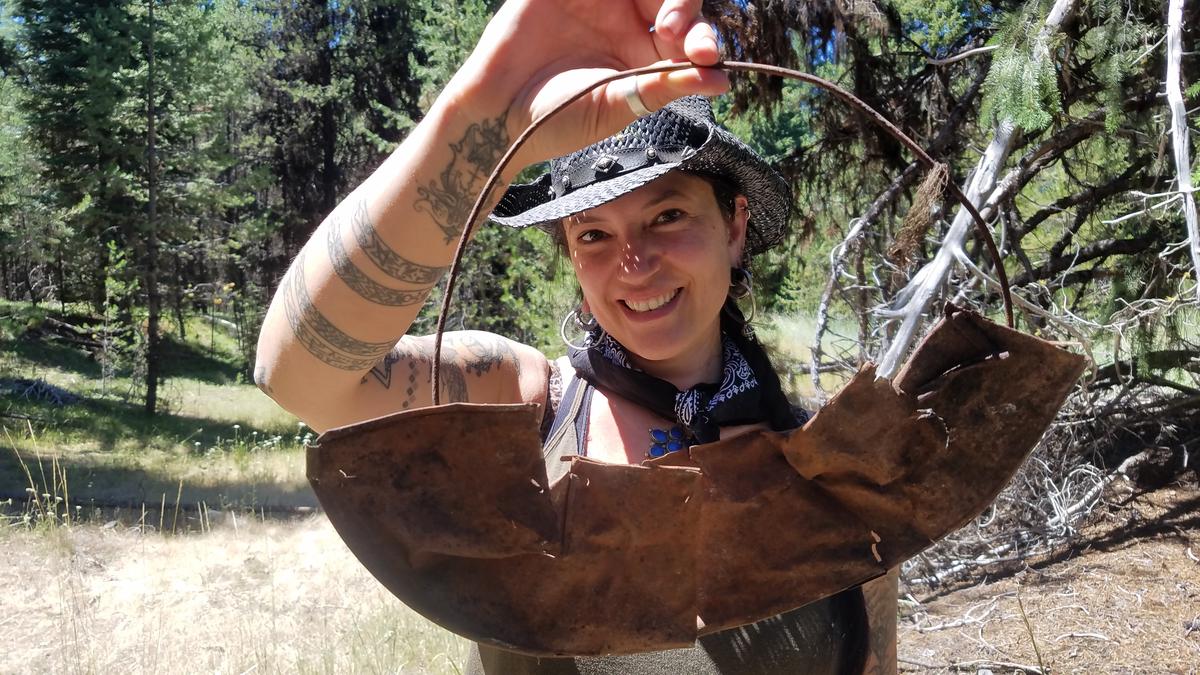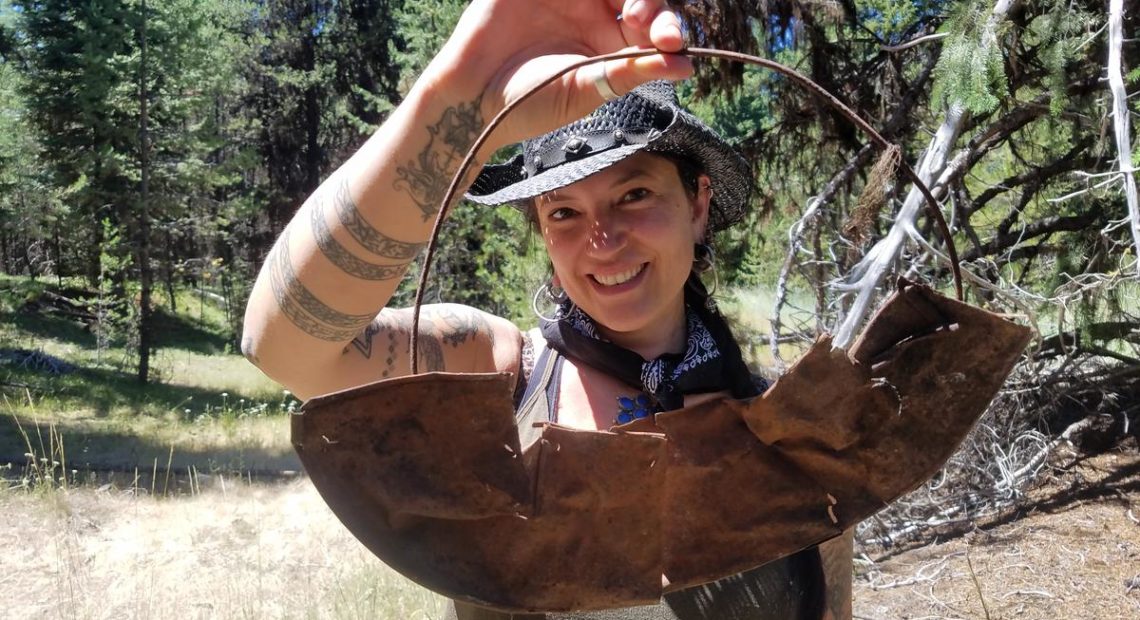
High-Tech Archaeology Helps Uncover Stories Of Long-Lost Gold Miners
Listen
Lewis Somers looked a bit like a prospector with his sun hat tipped back, eyes glued to the ground and tools strapped to his belt. Last week, you could have found him in the eastern Oregon town of John Day, pulling a ground-penetrating radar on a small sled back and forth across a gravel parking lot. Somers was prospecting, but not anything like the gold miners of old whose trail he followed.
“See here on the screen,” he said pointing to squiggles on a digital display propped on his chest. “There’s an interesting feature right here.”
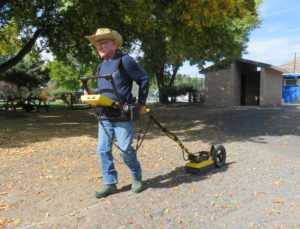
Lew Somers pulls a ground-penetrating radar instrument at Kam Wah Chung State Heritage
CREDIT: TOM BANSE
Somers, a principal with Archaeo-Physics LLC, was part of a team hired by Oregon State Parks to help find traces of the former Chinatown in John Day. Immigrant Chinese miners poured into eastern Oregon after a gold strike in 1861. None of their descendants remain, leaving it to archaeologists to breathe life into their stories.
By 1885, the small town of John Day had one of the biggest Chinatowns in the U.S. after San Francisco, Portland and Tacoma. Now there’s just one solitary building left of what might have been 100 structures at the town’s peak.
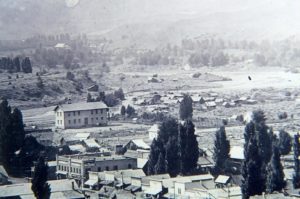
Historic photo of John Day from around 1905 showing the now-vanished Chinatown neighborhood at the upper right. CREDIT: OREGON STATE PARKS
“We can make excellent images of what is underground down to about two meters, a meter and a half or so,” said Somers, who lives in Portland. “Ninety-some percent of the world’s archaeology, especially in North America, is within the first three or four feet of the surface.”
The survey at the Kam Wah Chung State Historic Site involved no digging, no trowels or dusty researchers in trenches. Southern Oregon Universityarchaeologist Chelsea Rose, the co-principal investigator, said the team probed the earth without disturbing the earth by using aerial photos, ground-penetrating radar and a fancier version of a hand-held metal detector called a magnetometer.
Rose said archaeology could be an important tool to flesh out the lives of people who left few records before they moved on or were chased away.
“Most of these rural communities once had hundreds, if not thousands, of Chinese residents,” Rose said in an interview. “That story is lost if we are not there to kind of make sure it is added back into the history books. Not just as an exotic footnote of, ‘Oh, Chinese miners were here. Or, Chinese built the railroad.’ There’s a lot more substantial history and personal stories — you know, there’s a lot more to add to that narrative.”
It is a pursuit she foresees taking far beyond mining history in Grant County, Oregon.
“We know Chinese immigrants were a critical component of Oregon’s early history — in the mines, in the railroads, in the cannery business on the coast, in the hop fields and different agriculture,” Rose continued. “So really, there’s no end to how big this project can get.”
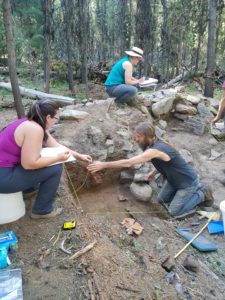
In July, archaeology volunteers unearthed and documented several Chinese mining sites northeast of John Day in the Malheur National Forest.
CREDIT: SOULA
Rose said a separate effort of what is now called the Oregon Chinese Diaspora Project will look for Chinese rail worker camps along the Oregon & California Railroad in the Cascade-Siskiyou National Monument. That project is supported by the federal Bureau of Land Management.
The multi-year, multi-agency project extends into the forested hills and gullies of the Malheur National Forest around John Day. That part of the investigation relied heavily on LIDAR, a laser beam instrument that produces detailed surface maps. U.S. Forest Service archaeologist Don Hann, co-principal investigator with Rose, said mining sites revealed by LIDAR show Chinese immigrants had a much bigger presence than previously assumed.
“It’s pretty solid that about 80 percent of the gold miners out here from about 1866 through 1900 were Chinese,” Hann reported. “That just flipped my way of looking at it. We should assume it is Chinese until we show it’s not.”
Hann said four excavations this summerof ruined miners’ camps turned up hundreds of artifacts that speak to daily life. The researchers found signs of active trade between the wilds of Oregon and San Francisco and southern China. Things they found included preserved ginger, imported ceramics, and opium cans and pipes.
Opium was legal in the U.S. until 1909. “It’s ubiquitous,” Rose said.
The project partners plan to return next summer with a corps of students and citizen volunteers to do more excavation and “ground truth” what the remote sensing data uncovered.
This month’s archaeological survey in John Day has practical relevance to Oregon State Parks, which has ambitions to expand the increasingly popular Kam Wah Chung historical site.
The state parks department has acquired or is negotiating to buy surrounding parcels of land and wants to build a new interpretive center in the next two or three years.
“Wherever we choose to put the new building, we want to make sure that we don’t disturb anything underground that may still be culturally significant,” said Kam Wah Chung museum curator Don Merritt in an interview.
Merritt said he wants to interpret whatever is left of the former Chinatown, perhaps by marking former structure locations with “ghost foundations.”
Rose, the Southern Oregon University archaeologist, said last week’s digital subsurface probing appears to have turned up remnants of a row of buildings across from the surviving Kam Wah Chung building.
“That is pretty exciting, and will help us to orient the existing building within the footprint of the historic community,” said Rose.
Copyright 2018 Northwest News Network
Related Stories:
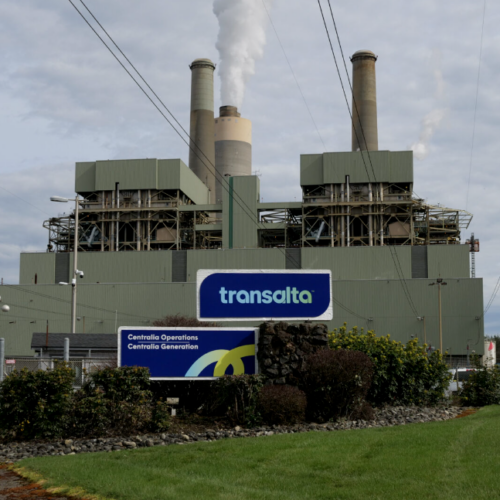
Centralia, Wash.’s coal plant has to close next year. Can Pa. communities learn from Centralia’s transition?
By: Rachel McDevitt, StateImpact Pennsylvania at WITF This story was produced as part of Climate Solutions, a collaboration focused on community engagement and solutions-based reporting to help Central Pennsylvania move toward
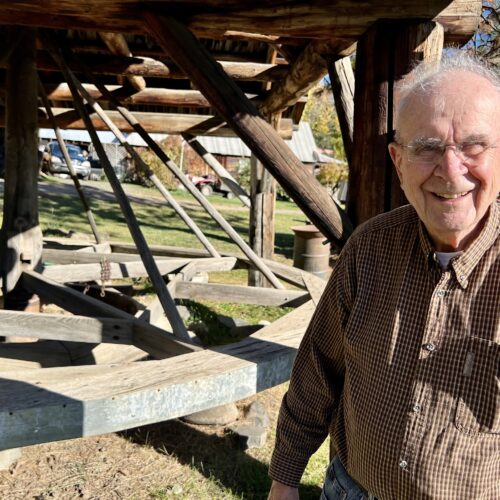
Washington’s only ‘living ghost town’ is full of history and a few lingering residents
Wes Engstrom, 91, first came to Liberty, Wash., in 1971 in search of gold. He’s standing in front of the town’s oldest working mining equipment called an arrastra. (Credit: Courtney
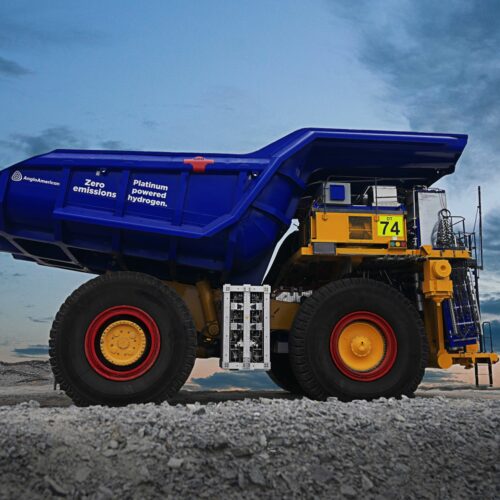
Battery-powered mining trucks to see test run in Lewis County
The site of the last coal-fired power plant in Washington state will soon be home to proving grounds for a carbon-emissions free mining truck.
The truck is a battery and hydrogen fuel cell powered vehicle, developed by Seattle-based First Mode, and it’s the largest emissions free vehicle in the world. Chris Voorhees, co-founder and chief product and technology officer at First Mode, said they’ve developed the technology to focus on decarbonizing the industry that provides the products that fuel our daily lives. Unlike other cleantech engineering focused on the consumer-end products like electric vehicles and solar panels, Voorhees said First Mode is looking at the opposite end of the supply chain.

